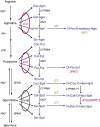Metabolome-based genome-wide association study of maize kernel leads to novel biochemical insights
- PMID: 24633423
- PMCID: PMC3959190
- DOI: 10.1038/ncomms4438
Metabolome-based genome-wide association study of maize kernel leads to novel biochemical insights
Abstract
Plants produce a variety of metabolites that have a critical role in growth and development. Here we present a comprehensive study of maize metabolism, combining genetic, metabolite and expression profiling methodologies to dissect the genetic basis of metabolic diversity in maize kernels. We quantify 983 metabolite features in 702 maize genotypes planted at multiple locations. We identify 1,459 significant locus-trait associations (P≤1.8 × 10(-6)) across three environments through metabolite-based genome-wide association mapping. Most (58.5%) of the identified loci are supported by expression QTLs, and some (14.7%) are validated through linkage mapping. Re-sequencing and candidate gene association analysis identifies potential causal variants for five candidate genes involved in metabolic traits. Two of these genes were further validated by mutant and transgenic analysis. Metabolite features associated with kernel weight could be used as biomarkers to facilitate genetic improvement of maize.
Figures



References
-
- DeLuca V. et al. Mining the biodiversity of plants: a revolution in the making. Science 336, 1658–1661 (2012). - PubMed
-
- Milo R. & Last R. L. Achieving diversity in the face of constraints: lessons from metabolism. Science 336, 1663–1667 (2012). - PubMed
-
- Griffin J. L. Understanding mouse models of disease through metabolomics. Curr. Opin. Chem. Biol. 10, 309–315 (2006). - PubMed
-
- Fernie A. R. & Schauer N. Metabolomics-assisted breeding: a viable option for crop improvement? Trends Genet. 25, 39–48 (2009). - PubMed
Publication types
MeSH terms
LinkOut - more resources
Full Text Sources
Other Literature Sources
Molecular Biology Databases

